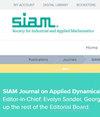Hawkes Process Modelling for Chemical Reaction Networks in a Random Environment
IF 1.8
4区 数学
Q2 MATHEMATICS, APPLIED
引用次数: 0
Abstract
SIAM Journal on Applied Dynamical Systems, Volume 23, Issue 3, Page 2444-2488, September 2024.Abstract.Cellular processes are open systems, situated in a heterogeneous context, rather than operating in isolation. Chemical reaction networks (CRNs) whose reaction rates are modelled as external stochastic processes account for the heterogeneous environment when describing the embedded process. A marginal description of the embedded process is of interest for (i) marginal simulations that bypass the co-simulation of the environment, (ii) obtaining new process equations from which moment equations can be derived, (iii) the computation of information-theoretic quantities, and (iv) state estimation. It is known since Snyder’s and related works that marginalization over a stochastic intensity turns point processes into self-exciting ones. While the Snyder filter specifies the exact history-dependent propensities in the framework of CRNs in a Markov environment, it was recently suggested to use approximate filters for the marginal description. By regarding the chemical reactions as events, we establish a link between CRNs in a linear random environment and Hawkes processes, a class of self-exciting counting processes widely used in event analysis. The Hawkes approximation can be obtained via a moment closure scheme or as the optimal linear approximation under the quadratic criterion. We show the equivalence of both approaches. Furthermore, we use martingale techniques to provide results on the agreement of the Hawkes process and the exact marginal process in their second-order statistics, i.e., covariance, auto/cross-correlation. We introduce an approximate marginal simulation algorithm and illustrate it in case studies.
随机环境中化学反应网络的霍克斯过程建模
SIAM 应用动力系统期刊》,第 23 卷第 3 期,第 2444-2488 页,2024 年 9 月。 摘要.细胞过程是一个开放系统,位于异质环境中,而不是孤立运行。化学反应网络(CRN)将反应速率模拟为外部随机过程,在描述嵌入过程时考虑了异质环境。嵌入过程的边际描述对于以下方面具有重要意义:(i) 绕过环境协同模拟的边际模拟;(ii) 获得新的过程方程,并从中导出矩方程;(iii) 计算信息理论量;以及 (iv) 状态估计。自斯奈德及相关著作以来,人们就知道随机强度的边际化会将点过程转化为自激过程。虽然斯奈德滤波器在马尔可夫环境下的 CRN 框架中精确指定了与历史相关的倾向性,但最近有人建议使用近似滤波器来进行边际描述。通过将化学反应视为事件,我们在线性随机环境中的 CRN 与霍克斯过程(一类广泛应用于事件分析的自激计数过程)之间建立了联系。霍克斯近似可通过矩闭合方案或二次准则下的最优线性近似获得。我们展示了这两种方法的等价性。此外,我们利用马氏技术提供了霍克斯过程和精确边际过程在二阶统计(即协方差、自相关/交叉相关)方面的一致性结果。我们介绍了一种近似边际模拟算法,并通过案例研究加以说明。
本文章由计算机程序翻译,如有差异,请以英文原文为准。
求助全文
约1分钟内获得全文
求助全文
来源期刊

SIAM Journal on Applied Dynamical Systems
物理-物理:数学物理
CiteScore
3.60
自引率
4.80%
发文量
74
审稿时长
6 months
期刊介绍:
SIAM Journal on Applied Dynamical Systems (SIADS) publishes research articles on the mathematical analysis and modeling of dynamical systems and its application to the physical, engineering, life, and social sciences. SIADS is published in electronic format only.
 求助内容:
求助内容: 应助结果提醒方式:
应助结果提醒方式:


